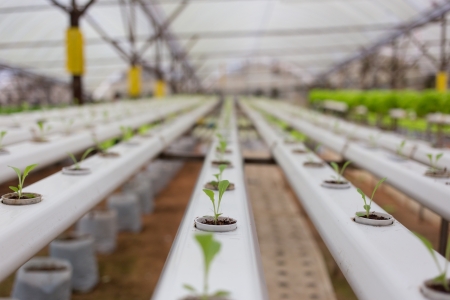Introduction to Hydroponics: An Urban Farming Revolution
India is witnessing a remarkable shift in the way food is grown, thanks to the rapid adoption of hydroponics—a method of cultivating plants without soil. As Indian cities expand and farmland becomes increasingly scarce, urban youth are searching for innovative and sustainable ways to contribute to the nation’s food security. Hydroponics stands out as a modern solution that aligns with India’s vision for smart cities and green growth. By utilizing limited spaces such as rooftops, balconies, and urban plots, this technology empowers young entrepreneurs to grow fresh produce right in the heart of bustling metros. The appeal goes beyond just space-saving; hydroponics significantly reduces water usage, eliminates harmful pesticides, and produces higher yields all year round. With its potential to transform agriculture amidst rapid urbanization, hydroponics is fast becoming an exciting frontier for Indian youth eager to cultivate both crops and careers in the new era of urban farming.
2. Why Hydroponics Appeals to Indian Youth
The surge in hydroponics business opportunities is capturing the imagination of India’s younger generation, blending the nation’s rich agricultural heritage with the pulse of modern technology. Young Indians are increasingly drawn to hydroponics due to its innovative approach to farming, offering a smart solution to traditional challenges such as shrinking arable land, water scarcity, and urbanisation. This new wave of agripreneurs recognises the potential of hydroponics not just as a business but as a sustainable movement aligning with global trends and local needs.
India’s youth are well-positioned to tap into these opportunities thanks to their adaptability, tech-savviness, and entrepreneurial mindset. With government initiatives like Startup India and Atmanirbhar Bharat actively supporting agri-tech ventures, young entrepreneurs find themselves at the confluence of policy support and market demand. Hydroponics appeals especially to those who wish to reconnect with their agricultural roots while leveraging cutting-edge technologies such as IoT monitoring, automation, and data analytics. This unique blend of tradition and innovation makes hydroponics an aspirational career path for many urban and semi-urban youth.
Key Factors Driving Youth Interest in Hydroponics
| Factor | Description |
|---|---|
| Modern Technology Integration | Use of sensors, AI, and automation for efficient farm management |
| Sustainability Focus | Reduces water usage by up to 90%, promotes eco-friendly practices |
| Urban Space Utilisation | Enables farming in cities, rooftops, and unused spaces |
| Government Support | Subsidies, training programs, and start-up incentives for agri-tech businesses |
| Market Demand | Rising consumer preference for clean, pesticide-free produce |
Cultural Resonance with Indian Values
Hydroponics also aligns with traditional Indian values of respecting nature (Prakriti) and fostering self-reliance (Swavalamban). Many young people see it as a chance to honour their family’s agricultural legacy while building a future-ready business model. The spirit of jugaad—innovative problem-solving—finds new expression in how Indian youth adapt global hydroponic techniques to local conditions, from growing leafy greens in Mumbai apartments to setting up commercial farms on the outskirts of Bengaluru.
The Way Forward for Indian Youth Entrepreneurs
As India’s urban landscapes expand and environmental concerns grow, hydroponics stands out as both a lucrative business opportunity and a means of addressing food security challenges. By embracing this fusion of old wisdom and new tools, young Indians are not only creating jobs for themselves but also contributing to a healthier and more sustainable future for the country.

3. Market Potential for Hydroponics in India
The Indian hydroponics market is experiencing remarkable growth, driven by evolving consumer preferences and urban lifestyle shifts. With increasing health awareness among the urban population from Mumbai to Bengaluru, there is a surging demand for residue-free, pesticide-free vegetables. This trend is especially prominent among young professionals and families seeking safer and fresher food options amidst concerns about conventional farmings chemical use.
Urban centers such as Delhi NCR, Hyderabad, and Pune have become hotbeds for hydroponics startups, as space constraints and high real estate costs make traditional agriculture less viable. Hydroponic farming allows efficient use of rooftops, balconies, and small plots, making it an attractive solution for densely populated cities. This creates substantial opportunities for youth entrepreneurs to tap into niche markets like premium supermarkets, organic food stores, and direct-to-consumer delivery models.
Lifestyle changes are also influencing the market potential. The fast-paced urban life has given rise to a growing preference for convenience foods that are both nutritious and fresh. Hydroponically grown vegetables offer superior quality, extended shelf-life, and traceability—attributes highly valued by today’s Indian consumers. Furthermore, the expanding middle class is willing to pay a premium for safe and clean produce, further boosting the commercial viability of hydroponics ventures.
4. Essential Skills and Knowledge Needed
For young Indian entrepreneurs to thrive in the hydroponics business, acquiring a specific set of skills and understanding local resources is crucial. Hydroponics is more than just growing plants without soil; it is a blend of science, technology, and business acumen tailored for India’s unique climate and market demands.
Practical Skills for Hydroponics Success
First and foremost, basic horticultural knowledge is essential. This includes understanding plant nutrition, pest management, and optimal growth conditions for high-yield crops like spinach, coriander (dhania), mint (pudina), and lettuce—vegetables popular in Indian kitchens. Additionally, technical proficiency in system maintenance, such as managing water pH, nutrient balance, and ensuring proper aeration, can prevent costly errors.
Leveraging Local Resources
Indias diverse agro-climatic zones offer unique advantages. Utilizing locally available materials—for example, coconut coir as a growing medium or repurposing old plastic drums for nutrient tanks—can reduce initial setup costs. Engaging with local suppliers for seeds and nutrients also supports community businesses and ensures freshness.
Key Local Resources Table
| Resource | Local Example | Benefit |
|---|---|---|
| Growing Medium | Coconut Coir (Kerala, Tamil Nadu) | Sustainable & affordable |
| Nutrient Solution | Locally sourced fertilizers | Cost-effective & accessible |
| Water Supply | Borewell/Rainwater Harvesting | Reduces dependency on municipal water |
| Crops Selection | Pudina, Dhania, Lettuce | High local demand & fast growth cycles |
| Infrastructure Materials | Recycled plastics/metal pipes | Low-cost system construction |
Training Opportunities for Indian Youths
A range of training opportunities are available across India, from government-sponsored Krishi Vigyan Kendras (KVKs) to private online courses. Many urban farming startups conduct workshops in cities like Bengaluru, Pune, and Hyderabad. Participating in these programs imparts hands-on experience in managing hydroponic systems and introduces scalable business models suitable for both rural and urban settings.
Popular Training Providers:
- Kvks (Krishi Vigyan Kendras): Offers practical field training across India.
- IARI (Indian Agricultural Research Institute): Provides certificate courses on protected cultivation.
- Agritech Startups: Firms like UrbanKisaan and Barton Breeze host regular skill-building sessions.
Understanding Scalable Business Models
Youth entrepreneurs should explore different hydroponics business formats—from small home-based setups to larger commercial farms or even rooftop farming ventures in cities like Mumbai or Delhi. Building partnerships with local restaurants or mandis for direct supply can ensure stable revenue streams while reducing food miles—a rising concern among urban consumers.
5. Challenges and Solutions in the Indian Context
Understanding the Unique Indian Landscape
The adoption of hydroponics in India comes with its own set of challenges, shaped by the country’s diverse climates, water quality variations, financial constraints, and deep-rooted agricultural traditions. For Indian youth venturing into this field, it is essential to recognise and address these region-specific hurdles with innovative, culturally relevant solutions.
Climate Variability Across Regions
India’s climatic conditions range from humid coastal regions to arid interiors, impacting hydroponic system design and management. In hot states like Rajasthan or Telangana, maintaining optimal temperature for nutrient solutions can be challenging. Deploying cost-effective cooling systems such as shade nets, evaporative coolers, or localised drip irrigation within hydroponic setups can help manage heat stress on plants without excessive energy consumption.
Water Quality and Availability Issues
While hydroponics is water-efficient compared to traditional farming, access to clean water remains a concern in many areas. Hard water with high mineral content or contaminants may harm plant growth. Testing water sources and investing in basic filtration units or reverse osmosis systems are practical steps. Collaborating with local panchayats and NGOs for community-level water purification projects can further empower rural youth entrepreneurs.
Cost Constraints and Financing
Initial investment in hydroponic infrastructure might seem daunting for young entrepreneurs. However, creative solutions like modular setups using recycled materials, phased expansion, and participation in government schemes such as the Pradhan Mantri Krishi Sinchai Yojana (PMKSY) can help reduce costs. Approaching local cooperative banks or leveraging start-up grants tailored for agri-businesses also opens up avenues for funding.
Cultural Practices and Mindset Shift
A significant challenge is the deep respect for conventional soil-based farming among Indian families. Youth must act as changemakers by demonstrating pilot projects that showcase higher yields, reduced pesticide use, and year-round production through hydroponics. Organising community workshops, engaging local elders, and sharing success stories in regional languages can bridge the knowledge gap and build trust.
Grounded Solutions for Sustainable Growth
Tackling these challenges requires a blend of scientific understanding and cultural sensitivity. By adapting technology to local realities—whether it’s using locally available materials or aligning crop choices with regional preferences—Indian youth can transform obstacles into stepping stones for a greener urban future. The journey demands persistence but offers immense potential for economic growth, food security, and urban renewal across India.
6. Government Schemes and Support for Youth Agripreneurs
In recent years, the Indian government has recognized the immense potential of hydroponics and other agritech ventures in transforming the agricultural sector. To nurture youth entrepreneurship, several schemes and initiatives have been launched to support young agripreneurs financially and technically.
Mudra Yojana: Empowering Young Entrepreneurs
The Pradhan Mantri Mudra Yojana (PMMY) is a flagship scheme that offers collateral-free loans to micro and small enterprises, including those venturing into hydroponics. Youngsters aspiring to start a hydroponics business can avail themselves of Mudra loans under three categories—Shishu, Kishor, and Tarun—depending on their funding needs. This financial support helps bridge the gap between innovative ideas and execution, making it easier for youth from urban and rural backgrounds to set up sustainable agri-businesses.
Startup India and Incubation Support
Startup India, an initiative by the Government of India, offers a plethora of benefits for agritech startups. These include tax exemptions, easier compliance norms, mentorship opportunities, and access to various incubators specifically designed for agriculture and technology ventures. Many Indian universities and research institutions now house agri-incubators that provide technical training, business development support, and networking opportunities for budding hydroponic entrepreneurs.
NABARD’s Role in Agritech Financing
The National Bank for Agriculture and Rural Development (NABARD) also extends support through its dedicated schemes for high-tech farming methods such as hydroponics. By offering low-interest loans, grants, and subsidies, NABARD plays a pivotal role in encouraging youth to adopt innovative agricultural practices and contribute to India’s food security.
State-Specific Initiatives
Several state governments have introduced tailored programs to boost hydroponics adoption among local youth. For instance, Maharashtra’s Agri-Business Incubation Centre and Karnataka’s Raita Siri scheme offer specialized guidance and incentives. These localized efforts ensure that young entrepreneurs receive region-specific support based on climate, market demand, and resource availability.
With robust government backing in the form of financial assistance, incubation programs, and policy-level encouragement, Indian youth are better equipped than ever to harness the power of hydroponics. By leveraging these schemes, aspiring agripreneurs can transform vacant urban spaces into productive green hubs while contributing to India’s journey towards sustainable agriculture.
7. Stories of Young Hydroponic Pioneers Across India
Delhi Rooftops: Turning Urban Dreams Green
On the bustling rooftops of Delhi, a group of young graduates led by Riya Mehra has transformed idle concrete terraces into lush hydroponic gardens. Despite limited space and water scarcity, their innovative approach has produced fresh lettuce, herbs, and tomatoes for local markets and cafes. By harnessing online platforms for direct sales, they have inspired hundreds of other urban youth to convert unused spaces into profitable green ventures. Their story is a testament to how urban India can actively contribute to sustainable food production through hydroponics.
Rural Maharashtra: Sowing Seeds of Change
In the heartlands of Maharashtra, Sachin Patil, a 24-year-old engineering dropout from Sangli, returned to his village with a vision—to introduce soilless farming in an area plagued by unpredictable monsoons. With government support and YouTube tutorials, Sachin built a cost-effective hydroponic setup using locally available materials. Today, his farm supplies leafy greens to Pune’s restaurants while providing employment opportunities for local youth. Sachin’s journey highlights how hydroponics can empower rural entrepreneurs, mitigate risks due to climate variability, and create thriving agri-businesses in smaller towns.
Bangalore Startups: Merging Tech with Agriculture
Bangalore’s reputation as India’s Silicon Valley extends beyond IT—young entrepreneurs like Arvind Krishna are integrating IoT technology with hydroponics to optimize nutrient delivery and plant growth. Their startup has not only attracted angel investors but also collaborated with schools to educate students about modern farming techniques. By merging technology and agriculture, these startups demonstrate that Indian youth can drive innovation in the country’s agri-sector while making farming attractive and lucrative.
Kolkata’s Community Gardens: Women Leading the Way
A collective of young women in Kolkata’s suburbs launched a community hydroponic garden project aimed at empowering homemakers and unemployed girls. Through training workshops and microloans, they have created a self-sustaining business model selling organic greens door-to-door. Their initiative proves that hydroponics is inclusive and can uplift entire communities by promoting skill development and financial independence among women.
Across India: A Growing Movement
From Chennai tech hubs to the hills of Himachal Pradesh, countless stories echo a similar theme—Indian youth are reshaping agriculture with passion and ingenuity. These pioneers are not only addressing food security but also building viable businesses that respect the environment and foster social change. As more young Indians embrace hydroponics, their journeys will continue to inspire others across Bharat to cultivate dreams—one seedling at a time.


